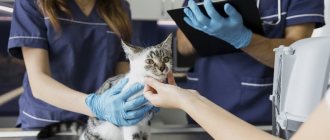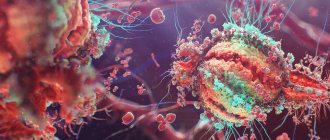Rabies (hydrophobia, hydrophobia, rabies) is a dangerous infectious disease of all warm-blooded animals caused by an RNA virus.
The disease is characterized by severe damage to the central nervous system, accompanied by paresis/paralysis and 100% mortality.
The causative agent of the infection is a neurotropic filterable virus that is weakly stable in the external environment, but in animal corpses it can retain its virulent properties for weeks.
Carnivorous mammals - foxes, mustelids, bats, moles, squirrels, rats, mice, etc., which spread rabies, have increased susceptibility. Weakly sensitive to the poultry virus.
The incidence depends on the following factors:
- method of infection
- infectious dose of the incoming pathogen and its virulence
- species, age and genetics of the animal
For example, a deep, dirty wound on the body of a young individual will most likely lead to a disease with a shorter incubation period than a superficial wound on the limb of an adult quadruped.
Causes of rabies
The source of infection is sick animals. Domestic cats are also at risk, as are stray or wild relatives, since contact with an infected mammal is possible.
The virus is contained in the saliva of an infected quadruped and is transmitted through a bite or salivation on damaged skin. Deep, low-bleeding muscle wounds, as well as bites in the head and neck area, are of great danger, due to their close location to the central nervous system.
The pathogen enters the brain along nerve fibers, then descends into the salivary glands, where it multiplies and begins to be released into the external environment.
What should you be wary of?
The more distant the injury site, the longer the latent period. From the moment of infection until the first symptoms appear, it can take from 6 days to 3 months. Under natural conditions, the incubation period lasts 1-2 months, but under some circumstances it can last up to 6 months.
Its duration depends on:
- general condition of the quadruped
- localization of the virus (bite site)
- nature of the wound
- pathogen strain
In the prodromal stage, signs of the disease may vary from person to person.
The previously affectionate and sociable pet becomes irritable and aggressive, constantly fighting. The cat can chew out the bite site and introduce the virus.
Shy and cowardly animals, on the contrary, become gentle and affectionate, constantly demanding the attention of the owner.
Soon the cat withdraws into itself, strives for solitude, has an absent gaze (it can sit in one place for hours, staring into space). Photophobia is also observed (the mammal avoids brightly lit places that irritate the eyes) and a desire to hide somewhere.
Most cats run away from home and die without being found.
According to the World Health Organization, rabies is one of the five infectious diseases common to humans and animals that cause the greatest social and economic damage. The infection is an acute, absolutely fatal disease that represents the most serious problem of modern healthcare.
WHO (World Health Organization) statistics:
- Rabies occurs in more than 150 countries.
- Worldwide, more than 55,000 people die from rabies every year.
- 40% of people who have been bitten by sick or suspected rabid animals are children under 15 years of age.
- Dogs are responsible for 99% of human deaths from rabies.
- Every year, more than 15 million people worldwide receive rabies vaccinations (rabies vaccinations) after exposure to animals that are sick or suspected of having rabies. This is estimated to prevent 327,000 rabies deaths per year.
Rabies is an acute viral zoonotic infection. The reservoir of infection in nature is carnivores and bats, in populated areas - domestic carnivores (dogs, cats) and farm animals.
The source of infection for humans are animals in the incubation period of the disease, or with a clinical picture of rabies, which is characterized by increased excitability and aggressiveness. Wild animals (wolves, foxes) can attack domestic animals and people.
INITIAL FINE RABIES CLINIC
The cat avoids people, becomes lethargic, has no appetite, and is reluctant to carry out usual commands. Sometimes the animal, on the contrary, becomes overly affectionate and intrusive. A cat's condition can change constantly. Your pet becomes irritable, fearful and restless. The cat can scratch or bite its owner, constantly listening to something and looking around. A sick animal refuses normal food and begins to swallow inedible objects such as branches, small toys, stones, and so on. The cat begins to chew on itself and itch constantly. Due to spasms of the pharyngeal muscles, the animal cannot swallow water - this is the most important symptom explaining rabies.
The animal becomes aggressive and even attacks people. The slightest rustle or bright light can frighten your pet. Attacks of rage are replaced by calm and oppression, this indicates weakness and exhaustion.
Animals may develop a squint, a loss of voice, a sagging lower jaw, and a protruding tongue.
PRIMARY CANINE RABIES CLINIC
The disease lasts 6-11 days and, as a rule, occurs in three stages.
First stage. The dog hides in dark places, does not respond to the owner’s call, or, on the contrary, caresses almost everyone - acquaintances and strangers, and tries to lick. This period is the most dangerous: the symptoms are not obvious, the signs of the disease are not obvious, but the dog is already a carrier of the rabies pathogen. It is enough for her to lick the damaged area of the skin for infection to occur.
Second stage. The symptoms are exactly those that give the disease its terrible name. The animal tries to break free from its leash and attacks any inanimate objects. The force of grasping movements is uncontrollable and so strong that even tooth destruction and jaw fractures are possible. Adrenaline levels rise, and in this state the dog can run up to hundreds of kilometers without stopping. At the same time, she is so excited that she becomes aggressive both with her relatives and with people - at the slightest provocation. Simply grabbing a briefcase or coughing is enough to provoke an attack. Unfortunately, people do not notice this reason and believe that a rabid dog attacks “just like that.” The barking becomes hoarse (the first signs of laryngeal paralysis), similar to a howl. Sometimes bouts of violence are followed by periods of peace.
Third stage. Lasts 2-4 days – semi-coma stage. The animal lies and dies in a coma.
THE MOST DANGEROUS BITES
Multiple and deep bites are considered severe, as well as any injuries to the head, face, neck, or arms. The virus penetrates through scratches, abrasions, open wounds and the mucous membranes of the mouth and eyes. With a bite to the face and head, the risk of contracting rabies is 90%, with bites on the hands - 63%, in the hands and feet - 23%. All animals that change their characteristic behavior or lose caution, attack for no reason, should be perceived as sick.
CLINIC OF THE DISEASE IN HUMAN
The incubation period for rabies ranges from short (9 days) to long (99 days), but averages 30–40 days. This period may be shortened if the bite was on the head, and lengthened if the bite was on the limbs. All this time the person feels satisfactory. Well, except that he feels a pulling and aching pain at the site of the bite and along the nerves and itching appears. The scar sometimes becomes inflamed. These symptoms are especially common 1–14 days before the onset of the disease.
SYMPTOMS OF RABIES
Rabies mainly affects those who did not seek medical help or who sought it late. Another reason is violation of the schedule during vaccinations and reluctance to complete the course of immunization.
The first symptoms of rabies: weakness, headache, general malaise, lack of appetite, slight increase in temperature, cough, runny nose, sore throat, abdominal pain, vomiting, diarrhea. They can be attributed to any disease, but most often they are mistakenly diagnosed as a respiratory or intestinal infection.
In humans, the disease is 100% fatal.
Measures to prevent the occurrence of rabies cases among people include:
- improvement of populated areas, creation of conditions that prevent the accumulation of stray animals: cleaning areas of garbage, eliminating spontaneous landfills, equipping container sites with containers for storing food and household waste and regular cleaning and removal of solid waste;
- compliance with the rules for keeping and walking domestic animals and their mandatory immunization against rabies;
- immunization against rabies of farm animals.
In order to prevent people from becoming infected with rabies, in case of attack, contact, salivation and bites by wild, unknown, or suspected rabies animals, it is necessary to immediately seek medical help.
Anti-rabies treatment includes local treatment of the wound, carried out as soon as possible after a bite or injury and the introduction of an anti-rabies vaccine, and in the case of bites, salivation of a dangerous localization (mucous membranes, any bites of the head, face, neck, hands, fingers and toes, multiple bites any localization) additional administration of rabies immunoglobulin. The vaccinator must know: he is prohibited from consuming any alcoholic beverages during the entire course of vaccinations and 6 months after its completion; You should also avoid overwork, hypothermia, and overheating. The course of therapeutic and prophylactic immunization against rabies consists of 6 vaccinations according to the schedule: 0 (on the day of application), and then on the 3rd, 7th, 14th, 30th and 90th days. If the bitten animal was monitored and remained healthy within 10 days after the bite, then further injections are stopped.
In the city of Moscow and the Moscow region, a tense natural and epidemiological situation regarding rabies remains.
Laboratory confirmed cases of rabies in animals are registered annually.
The animal should be shown to a veterinarian. To exclude the disease, he is monitored for 10 days. If after 10 days the animal turns out to be healthy, then the course of vaccinations is stopped ( the victim must receive at least 3 vaccinations ). An important measure in the fight against rabies is the protection of domestic animals from contracting this infection, for which it is necessary to vaccinate animals, including livestock, annually. It must be remembered that animals that are on the street without owners are caught as strays. Therefore, dogs must be taken for walks on a leash or muzzle.
Do not allow children to play with stray dogs, cats, and especially wild animals!
First signs and symptoms
The disease in mammals occurs in several forms, which determines the symptoms. As the virus attacks brain tissue, encephalitis develops.
Stage 1 (harbingers):
- sudden change in behavior (desire for solitude, distrust or unusual affection, grumbling, frequent change of resting place)
- teeth chattering
- appetite is reduced or perverted (the cat swallows lime, wool, paper, stones, earth, wood chips); foreign objects are found in feces
- sometimes there is vomiting
- unexpected reaction to a stimulus (bright lighting, touch)
- possible development of pharyngeal paralysis (refusal of food and water)
Stage 2:
- constant anxiety (the cat runs away, rushes about, wanders aimlessly, aggression appears)
- increased excitability
- due to the paralysis of different muscle groups, swallowing is difficult, the tongue sticks out, saliva is released profusely, which whips into foam when moving the jaws
- having problems urinating and defecating
Stage 3:
- loss of coordination and paresis of limbs
- oppression, weakness
Death occurs from exhaustion and paralysis of the respiratory muscles.
Other rare types of pathology
Atypical rabies lasts quite a long time. This form resembles a violent one. However, the animal lacks excitability and there are disturbances in the gastrointestinal tract, for example, diarrhea.
Abortive type is a rare type of disease. At the beginning of the second phase of its development, symptoms suddenly disappear. The cat makes a full recovery. This form is still poorly studied. It is impossible to say what causes the cessation of the disease.
The recurrent type is characterized by a relapse of the pathology after an imaginary recovery. Attacks of hydrophobia alternate several times with a break of up to three weeks.
Manifestation of rabies in cats
The disease usually occurs acutely in a violent form, less often in a paralytic form. The clinical picture is similar in animals of all species.
Violent (aggressive) form
The course is acute, like a “crazy dog”. Cats become ferocious and angry, rushing at the owner, grabbing the face and neck. They inflict deep bites and violently grab hard objects, damaging the oral mucosa and breaking teeth.
Attacks of aggression are replaced by depression. Soon convulsive muscle contractions, fine trembling, and convulsions appear. Hoarse meowing and voice changes are often noted.
From the musculoskeletal system, a stumbling gait and incoordination of the hind limbs are observed.
If an animal is free, it is not afraid of anything and rushes at everyone it meets on the way. Death occurs 5-10 days after infection.
Paralytic (silent) form
Excitement and aggression are practically absent, the swallowing muscles are paralyzed, which causes coughing attacks and drooling. The cat scratches its mouth with its paw, trying to get rid of saliva.
As encephalitis develops, coordination of movements is impaired, paresis of the hind legs appears, the cat collapses and dies from respiratory arrest.
Is cat rabies dangerous for humans?
Since the relationship between cats and people has existed since time immemorial, infection is possible through a bite or saliva from a sick animal coming into contact with damaged skin or mucous membranes (eyes, lips, mouth and nasal cavity).
The disease is as deadly for humans as it is for animals!
Main types of hydrophobia
The following forms of hydrophobia exist:
- Violent (typical). It occurs most often.
- Paralytic, or silent.
- Abortive.
- Returnable.
- Atypical.
The first two types are similar to forms of the disease in humans. And the other three are observed only in representatives of the cat family.
Measures to prevent the spread of rabies
If there are any doubts about the health of the animal, you should not touch it, caress it or provide any assistance.
Any bites caused by a feral or stray cat (whether provoked or not) are potentially dangerous!
The mammal must be isolated from others and placed in quarantine for 10 days. The measures are aimed at preventing infection of other four-legged animals and humans.
After any contact with a suspicious four-legged animal, especially if there are signs of rabies and damaged skin exposed to the animal’s saliva, you must report the incident to the veterinary service and immediately go to the nearest emergency room or hospital for vaccination.
Development of preventive vaccines for people that are used to prevent the disease, especially among those who are directly involved with animals (veterinarians, shelter and nursery workers, laboratory workers, biologists).
There is no cure for rabies
At present, no effective treatment has been developed against the rabies virus. If there are obvious signs of the disease, the animal must be killed.
If a dangerous disease is suspected, the cat is immediately isolated in a separate room, and any contact with the rest of the family members is completely excluded.
In addition, the owner is obliged to inform the veterinary institution about signs of rabies in the pet, after which the animal is quarantined and placed in a special box. While the cat is in quarantine, she is closely monitored. Veterinary specialists, for their own safety, also do not carry out any therapeutic measures with the animal.
If a cat manages to bite its owner, it is necessary to immediately wash the bite site with plenty of warm water and laundry soap and treat the wound with any antiseptic. Next, immediately contact a medical facility for medical help. Anti-rabies serum is effective only in the first 3 days after the bite; if you miss precious time, the person may die.
Diagnosis of rabies in cats
An accurate diagnosis of rabies in cats can only be made posthumously! The corpse of a dead animal or its head is sent for research (a section from the brain is required).
Collection of epidemiological, clinical and pathological data is also required.
The analysis should exclude:
- pseudorabies (Aujeszky's disease)
- listeriosis
- botulism
Rabies may also be suspected if:
- poisoning with strychnine, lead, organochlorine compounds, benzoic acid
- colic, injuries
- severe forms of ketosis
- toxoplasmosis
- lesions of the central nervous system, spongiform encephalopathy
- hepatoencephalopathy
- feline infectious peritonitis
- presence of foreign bodies in the mouth, pharynx, blockage of the esophagus
- neoplasia
- thiamine deficiency
- general weakness due to infectious diseases
It is very difficult to diagnose paralyzed, discoordinated and dying animals.
Symptoms
The first signs of rabies in a cat can vary. They differ depending on what form of infection the cat has. There are 3 main types of process development:
- In the paralytic form, the pet loses its appetite and does not drink water. The cat tries to hide in a dark corner, hides under furniture and avoids communicating with the owner. When trying to get him out of hiding, he can fly into a rage and bite. The disease in this form progresses quickly, the cat dies within 3-4 days.
- The atypical form of rabies lasts a long time. Over the course of several months, a cat may gradually lose weight and suffer from a lack of appetite. She develops gastrointestinal abnormalities (diarrhea, vomiting). Weight loss increases and is accompanied by atrophy of the muscles of the limbs and torso, and cramps. At the end of the process, the animal dies. This form is rare.
- The violent form is considered the most common. The affected pet's behavior changes: it may be lethargic and avoid contact, show unusual affection, and rub its head against its owner. Most often at this time the animal’s appetite is disturbed or perverted. The cat begins to eat garbage or pebbles, but does not pay attention to the food. Itching appears at the site of the bite, and the animal constantly scratches the wound or bites it.
As the infection progresses, excessive salivation appears. It is accompanied by a spasm of the throat. This symptom can easily be mistaken for a sign that the cat has choked on a sharp bone. At the same time, the animal begins to show unmotivated aggression. Outbursts of rage give way to exhaustion. From a sharp sound, the pet begins to rush around again.
Due to the inability to eat and drink, the animal loses fatness, the coat becomes disheveled and unkempt. Paralysis of the pharynx and masticatory muscles leads to loss of voice, sagging of the lower jaw, and prolapse of the tongue. Strabismus develops, the pupils are most often dilated. The disease ends with paralysis of all muscles. The total duration of the process rarely exceeds 7-10 days. The animal dies from cardiac paralysis and asphyxia.
How to treat rabies in cats
Treatment has not been developed, but to avoid the disease it is necessary to vaccinate your pet annually. Immunity is formed in 2-3 weeks and protects the animal for 1 year.
If the cat is not vaccinated and there is a risk of illness (contact with wild and stray animals), it should be taken to a veterinary hospital for examination and quarantine. After 10 days, if there are no signs of illness, the cat is returned to the owner.
Handling mammals suspected of having a disease requires special care and hygiene measures: it is necessary to use eye and skin protection, wash your hands thoroughly with soap and regularly disinfect them.
Remember, there is no chance of surviving rabies!
Vaccination of cats is the basis of prevention
The main method of prevention is vaccination. The first vaccination is given to kittens who have reached the age of three months. Then the animal is vaccinated every year throughout its life.
Important! Rabies vaccination is mandatory and should be provided free of charge in all municipal veterinary clinics.
Only healthy animals are allowed to be vaccinated. Therefore, two weeks before the procedure, the cat is given a drug against helminths. Vaccination is not carried out during the animal's pregnancy. After vaccination, the veterinarian enters the relevant data into the cat’s passport and signs it. Without such a document, you will not be able to take your beloved pet on a trip.
Vaccination will help reduce the risk of contracting rabies.
There is no need to worry about side effects from vaccination. Modern medications are well tolerated by cats of any age. Anti-rabies vaccines of foreign production are used for vaccinations: Nobivak Rabies (Holland), Defensor-3 (USA), Rabisin (France).
During the procedure, multivalent drugs can be used, the action of which is aimed at pathogens of various infections. Such medications include the Quadricat vaccine. It fights not only the rabies virus, but also the respiratory infection.
Contact between your cat and animals whose health you doubt should be excluded. But this is quite problematic to do if the animal is kept in a private sector and has the opportunity to freely walk around the territory.
Rabies vaccination
Vaccination against rabies in cats is the only protection against a dangerous infection. Vaccination protects your pet and also protects others if your cat bites someone. Kittens are vaccinated against rabies at 12 weeks of age. Stable immunity to the virus is formed 21 days after vaccination.
Depending on the type of vaccine, immunity to this disease can last from 1 to 3 years. But veterinarians recommend annual revaccination. Weakened and elderly animals are allowed to be vaccinated once every two years.
What to do if you are bitten by a cat
Rabies is transmitted from cats to humans. Therefore, if you are bitten by a cat, you should immediately consult a doctor. Before visiting the clinic, try to collect information that will help the doctor make a diagnosis and prescribe treatment.
Facts to tell your doctor:
- the scene of the incident;
- object of contact (domestic cat or stray animal);
- type of contact (bite, contact with saliva on an open wound or mucous membranes, scratch);
- determine whether the bitten cat has a rabies vaccination;
- whether this animal was healthy or sick, what signs of illness were observed in it;
- whether the animal is available for quarantine or testing.
After this, you must undergo a course of vaccination within the time frame prescribed by your doctor. The first injection is administered on the day of the bite or on the day of contacting a medical facility.
Preventive measures
To protect your cat from becoming infected with a dangerous virus, follow these rules:
- Do not allow your pet to come into contact with wild animals. Do not let your cat roam freely in dachas and country houses.
- Protect your pet from meeting domestic cats and dogs whose health you are not sure of.
- Do not allow pets to approach or come into contact with dead animals.
- Make sure that indoor cats do not run outside or fall out of windows.
- In transport, transport cats only in comfortable, reliable transportation, from which the animal cannot jump out.
- Vaccinate and revaccinate cats against rabies in a timely manner.
Questions and answers
How long is the rabies virus contagious once it is outside of a rabid cat?
The Rabies virus is quickly destroyed outside the body of an infected animal. It stops living as soon as the saliva dries. The virus is easily killed by soap and other detergents and UV rays.
Can a domestic cat get rabies?
An unvaccinated pet can become infected through contact with sick wild and domestic animals, when it accidentally runs away from home or falls out of a window.
Can you get rabies from a cat scratch?
Yes, such a source of infection is possible. Cats constantly lick their paws; the virus can get onto their claws along with saliva.
How is rabies transmitted in cats?
The disease is transmitted through direct contact between a sick and healthy animal. The main method of transmission of the virus is the bite of a domestic cat or dog. But you can become infected through scratches and contact with the saliva of a rabid animal on open wounds and mucous membranes of the body.











